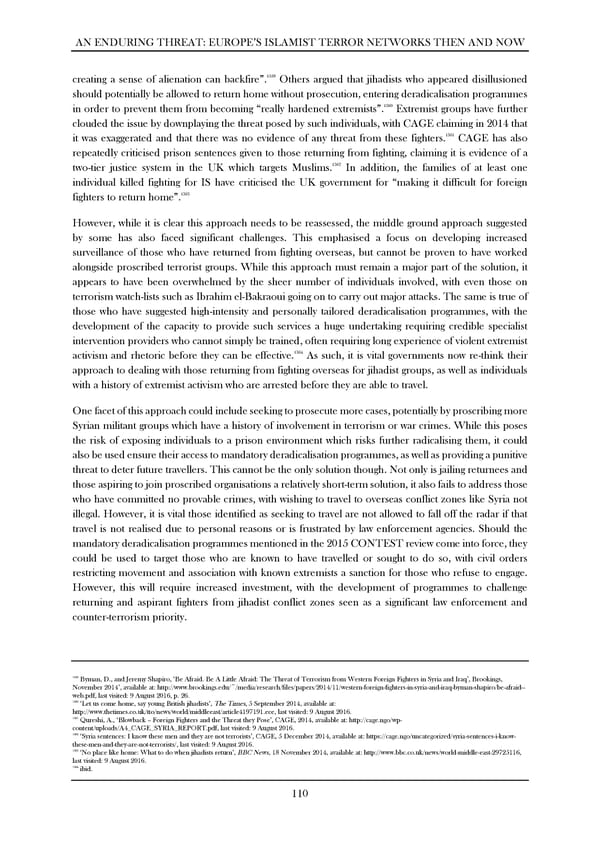AN ENDURING THREAT: EUROPE’S ISLAMIST TERROR NETWORKS THEN AND NOW 1359 creating a sense of alienation can backfire”. Others argued that jihadists who appeared disillusioned should potentially be allowed to return home without prosecution, entering deradicalisation programmes in order to prevent them from becoming “really hardened extremists”.1360 Extremist groups have further clouded the issue by downplaying the threat posed by such individuals, with CAGE claiming in 2014 that 1361 it was exaggerated and that there was no evidence of any threat from these fighters. CAGE has also repeatedly criticised prison sentences given to those returning from fighting, claiming it is evidence of a 1362 two-tier justice system in the UK which targets Muslims. In addition, the families of at least one individual killed fighting for IS have criticised the UK government for “making it difficult for foreign 1363 fighters to return home”. However, while it is clear this approach needs to be reassessed, the middle ground approach suggested by some has also faced significant challenges. This emphasised a focus on developing increased surveillance of those who have returned from fighting overseas, but cannot be proven to have worked alongside proscribed terrorist groups. While this approach must remain a major part of the solution, it appears to have been overwhelmed by the sheer number of individuals involved, with even those on terrorism watch-lists such as Ibrahim el-Bakraoui going on to carry out major attacks. The same is true of those who have suggested high-intensity and personally tailored deradicalisation programmes, with the development of the capacity to provide such services a huge undertaking requiring credible specialist intervention providers who cannot simply be trained, often requiring long experience of violent extremist 1364 activism and rhetoric before they can be effective. As such, it is vital governments now re-think their approach to dealing with those returning from fighting overseas for jihadist groups, as well as individuals with a history of extremist activism who are arrested before they are able to travel. One facet of this approach could include seeking to prosecute more cases, potentially by proscribing more Syrian militant groups which have a history of involvement in terrorism or war crimes. While this poses the risk of exposing individuals to a prison environment which risks further radicalising them, it could also be used ensure their access to mandatory deradicalisation programmes, as well as providing a punitive threat to deter future travellers. This cannot be the only solution though. Not only is jailing returnees and those aspiring to join proscribed organisations a relatively short-term solution, it also fails to address those who have committed no provable crimes, with wishing to travel to overseas conflict zones like Syria not illegal. However, it is vital those identified as seeking to travel are not allowed to fall off the radar if that travel is not realised due to personal reasons or is frustrated by law enforcement agencies. Should the mandatory deradicalisation programmes mentioned in the 2015 CONTEST review come into force, they could be used to target those who are known to have travelled or sought to do so, with civil orders restricting movement and association with known extremists a sanction for those who refuse to engage. However, this will require increased investment, with the development of programmes to challenge returning and aspirant fighters from jihadist conflict zones seen as a significant law enforcement and counter-terrorism priority. ! ! 1359 Byman, D., and Jeremy Shapiro, ‘Be Afraid. Be A Little Afraid: The Threat of Terrorism from Western Foreign Fighters in Syria and Iraq’, Brookings, November 2014’, available at: http://www.brookings.edu/~/media/research/files/papers/2014/11/western-foreign-fighters-in-syria-and-iraq-byman-shapiro/be-afraid-- web.pdf, last visited: 9 August 2016, p. 26. 1360 ‘Let us come home, say young British jihadists’, The Times, 5 September 2014, available at: http://www.thetimes.co.uk/tto/news/world/middleeast/article4197191.ece, last visited: 9 August 2016. 1361 Qureshi, A., ‘Blowback – Foreign Fighters and the Threat they Pose’, CAGE, 2014, available at: http://cage.ngo/wp- content/uploads/A4_CAGE_SYRIA_REPORT.pdf, last visited: 9 August 2016. 1362 ‘Syria sentences: I know these men and they are not terrorists’, CAGE, 5 December 2014, available at: https://cage.ngo/uncategorized/syria-sentences-i-know- these-men-and-they-are-not-terrorists/, last visited: 9 August 2016. 1363 ‘No place like home: What to do when jihadists return’, BBC News, 18 November 2014, available at: http://www.bbc.co.uk/news/world-middle-east-29725116, last visited: 9 August 2016. 1364 ibid. ! ! 110 !
 An Enduring Threat: Europe’s Islamist Terror Networks Then and Now Page 115 Page 117
An Enduring Threat: Europe’s Islamist Terror Networks Then and Now Page 115 Page 117